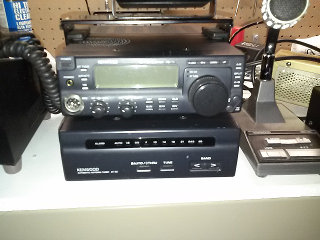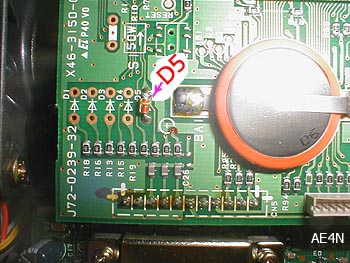Kenwood TS-50S
Kenwood TS-50 / Kenwood TS-50S - Amateur Radio / Ham Radio / HF band transceiver.
- adjustable to 10, 50 or 100 watts.
- LSB, USB, CW AM and FM.
- Dual VFO's,
- 100 memories,
- AIP, RIT, IF shift, AGC and TF-set
Contents
[hide]- 1 Kenwood Promotional
- 1.1 160 m ~ 10 m amateur band operation
- 1.2 AIP (Advanced Intercept Point)
- 1.3 Powerful menu system
- 1.4 DDS (Direct Digital Synthesizer) with step logic control
- 1.5 Comprehensive interference reduction
- 1.6 100 memory channels
- 1.7 Easy-to-use scan functions
- 1.8 Dual VFOs (A and B)
- 1.9 TF-SET
- 1.10 Multi-function microphone supplied
- 1.11 Optional external antenna tuner (AT-50)
- 1.12 Other Features
- 2 Operating
- 3 Optional Components
- 4 comments
- 5 MARS CAP MOD / Full TX Coverage
Kenwood Promotional
As small as it is, the TS-50S packs a powerful punch. Maximum output is 100 W, and there is an impressive range of features -- including 100 memory channels, DDS with innovative step logic control, and AIP for superior dynamic range. IF shift and CW reverse mode help reduce interference, while TF-SET facilitates split-frequency operations. Ensuring user-friendly operation on the move is a convenient menu system, which can also be accessed via the multi-function microphone. And there are several attractive options available to make the TS-50S even more versatile.
Features at a glance:
- 160 m ~ 10 m transceiver amateur operation
- 500 kHz ~ 30 MHz general coverage receiver
- DDS with "fuzzy logic" control
- AIP system
- 100 memory channels
- CW reverse
- Menu system
TS-50S in detail:
160 m ~ 10 m amateur band operation
The TS-50S offers transmit/receive performance equivalent to that of most large HF transceivers on the market. All modes -- LSB, USB, CW, AM and FM -- are built-in.
AIP (Advanced Intercept Point)
Further enhancing the first-class receiver performance of the TS-50S -- with a significantly reduced noise floor level -- is our AIP system. This exclusive circuit design is capable of raising dynamic range to 105 dB.
User-friendliness enters a new dimension with these versatile menus. First featured on the top-of-the-line TS-950SDX, this system allows the operator to select CW full or semi break-in, change repeater sub-tone, adjust microphone UP/DOWN step size, and perform many other operations using just a few keys. The menus are also accessible via the supplied microphone.
DDS (Direct Digital Synthesizer) with step logic control
We've introduced step logic control circuitry to enable the main encoder to tune smoothly from 5 Hz steps to fast forward mode. The operator may also select torque settings: high for mobile use, low for stationary applications.
Comprehensive interference reduction
- CW reverse mode: This reverses the pitch of interference competing with the CW signal, allowing the operator to approach the desired signal from either side.
- All-mode squelch: The squelch circuit effectively suppresses undesirable background noise when there is no signal present.
- Switchable AGC circuit (SLOW/FAST): AGC (automatic gain control) can be changed via the menu system. This ensures optimum receiver operation in SSB, AM and CW modes under all signal strength conditions.
- IF shift: The IF passband is moved away from interfering signals, thus maximizing gain and signal-to-noise ratio.
- Noise blanker: Pulse-type interference, such as ignition noise, can be eliminated.
- 20 dB RF attenuator
100 memory channels
The TS-50S is equipped with 100 channels for independent storage of transmit and receive parameters such as frequency, mode, and filter setting. Memory shift (for transfer of data to the VFOs), memory scroll, and memory protect functions are also provided.
Easy-to-use scan functions
The memory channels can be scanned either continuously or in groups; channel 99 stores the upper and lower limits for programmable band scan. Scan speed is variable, and selected channels can be skipped without data loss using the lock-out function. The TS-50S also offers a carrier-operated scan stop mode.
Dual VFOs (A and B)
VFO data is stored independently for each band, so even after switching bands the previously used frequency will still be available.
TF-SET
Provided for split-frequency operations and DX applications, TF-SET is available when the receive frequency is locked, so the operator can avoid losing a targeted DX station.
Multi-function microphone supplied
The TS-50S is similar to our other VHF mobile transceivers in more than just looks: this HF rig is compatible with remote-control microphones featuring 4 programmable function keys.
Optional external antenna tuner (AT-50)
Accurate tuning, even at band edges, is initiated simply by pressing the AT TUNE key on the TS-50S. Band data is transferred to the tuner, so there is no need to operate the AT-50 directly and it can be installed in an automobile trunk. (The optional PG-4M is required to mount the AT-50 remotely.)
Other Features
- RF output power control (100 W, 50 W, 10 W)
- Auto-mode capability
- Full break-in and semi break-in
- Large LCD panel with digital bar meter
- Auto power-off
- Optional 500 Hz CW filter (YK-107C)
- Optional automatic antenna tuner (AT-50 or AT-300)
- Optional SO-2 temperature-compensated crystal oscillator (TCXO)
- Optional computer interface adapters (IF-10D, IF-232C)
Dimensions (W x H x D)
- 179 x 60 x 233 mm (7.06 x 2.38 x 9.12 in.)
Operating
Controls are fairly straightforward. Only less intuitive functions covered.
Some buttons are multi-function based on short-press / long-press
Change Output / TX Power: long press the F.LOCK button to gain access to MENU SETTINGS. Menu #00 adjusts TX output power 100/50/10 watts
Other MENU SETTINGS that are more useful, Menu #02 controls automatic gain controls speed.
There are two different MENU SETTINGS, an A and B MENU SETTINGS. Kenwood divides them as (A) frequently used and (B) less frequently used.
To access the (A) MENU SETTINGS, such as adjusting TX power etc as mentioned above, long-press F.LOCK, and to get to the (B) MENU SETTINGS after long-press F.LOCK proceed to follow up by pressing A/B. By pressing A/B you can toggle between (A) and (B) MENU SETTINGS.
This transceiver does support PL/CTCSS for repeater access such as for a 10-meter FM repeater requiring PL. This is access via (B) MENU SETTING Menu #53.
Optional Components
Install Filter
Addition of optional internal filter requires solder filter onto board. Then changes need applied to Menu Setup.
- YK-107C CW Filter
Addition of optional TCXO Unit (SO-2) requires some removal of internal board then solder onto PC board. The use of TCXO (Thermally Compensated Cystal Oscillator) increases stability thus reduce frequency drift.
- SO-2 TCXO Unit
Tip: Since quartz crystals are temperature-sensitive, if you keep your shack at a constant temperature you will likely see no benefit to the TCXO option.
comments
The TS-50 did have capacitors that would leak. They were a strange hybrid, surface mount design. Look for black on the board around the capacitors. They can be replaced, and likely should be if you plan on keeping it for some time.
When power testing, be sure to test power on all bands. You may see full power taper off, or be significantly diminished on specific bands. Easy enough when power testing.
There is also a memory battery in these that if original, is likely bad. You can tell if it's bad if you change the frequency, then fully remove power. If it keeps the same frequency when you plug power back in, it's fine. If it goes back to the default frequency, it will need to be replaced.
CAT control is hit and miss with that radio and isn't as simple as just buying a cable and hooking it to your computer. TS-50 radios are somewhat collectible and go for between $350 and $500 on the QRZ.com swap forum. In 2012 they were selling on eBay for $400 +/- $50. That's what people are paying in sold listings.
Capacitors won’t likely be an issue. The rig isn’t old enough for that. You want to check output power on all bands, but pay special attention to the higher bands, and make sure all the buttons and knobs (particularly the VFO) are working properly and feel right. The VFO encoders can get weird and buttons can get soft.
Attempting to tune the AT-50 when it is connected to an antenna with a relatively high SWR value might cause the ACCY fuse to open in the TS-50S. This can be correct by Locate X53-3470-00 D/4 (It is attached to the top left side of the chassis with the foil side up)
and add the two .047 µF capacitors
The receiver can overload a bit easier than many larger radios. Dr. Ulrich Rhode wrote an article about this some years ago. It turns out that the switching diodes impacted the performance more than one might have expected. The TS-50 was designed to be small and simple to use on the road.
MARS CAP MOD / Full TX Coverage
Remove the bottom cover of the TS-50
Locate the PLL board -- it is the pc board on top of the main board, it has a shield on it's right side.
Locate the only non-surface mounted component on the PLL board -- look near the rear left-hand side of the pll board (front of radio facing you) and remove the very obvious diode. It is the only diode present.
Replace cover.
Perform microprocessor reset as described in your manual.
WARNING: If you want to make your TS50 tranceiving 0-30 and find more then 1 diode in your radio, PLZ watch out! Dnt remove diode nr1! Remove nr5.
WARNING: The new version of the TS 50 has three non surface mount diodes to be cut for general TX.
WARNING: Yet another new version has four diodes. Cut remove all, D1 D3 D4 D5
TS-50S in May 2001, to enable Wideband TX cut D3 &D4 on the digital unit X46 - 315X - XX.
TS-50S today 10/10/2001 the mod is the same except cut D5 as well to enable.
Then RESET the Kenwood TS-50
Reference: http://vss.pl/mods.dk/mods.php3-radio=kenwood&model=ts-50&selectid=all.htm

